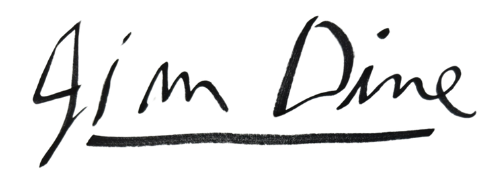HYPERALLERGIC, 2 APRIL 2024
Jim Dine Gets to Work
For Dine, physical labor and art-making are interchangeable: “When you paint every day, all year long, then the subject is essentially the act of working.”
John Yau April 2, 2024
The exhibition Jim Dine: The ’60s at 125 Newbury gallery confirms my long-held belief that Dine was never a Pop artist. A pioneer of Happenings, which emerged as a response to Abstract Expressionism and the possibilities of transgressing the boundaries of the canvas, his roots are located at the intersection of these two movements and their commitment to improvisation. Dine further complicates this chronological view because — unlike many other artists associated with Pop art — he is committed to the practice of drawing, and its basis in the Renaissance. In love with classical art, particularly contour drawing, his fluid line is unrivaled among artists of his generation, and is one of his contributions to postwar art.
This exhibition also reveals something about Dine’s work that I had not fully grasped in the past: drawing was there from the beginning. In the artist’s mind, physical labor and art-making are essentially interchangeable activities. On Templon gallery’s website, he is quoted as saying: “When you paint every day, all year long, then the subject is essentially the act of working.” For Dine, there is neither a gap between art and life (as with Robert Rauschenberg) nor a disdain for labor (as with Andy Warhol).
Objects are attached to all 11 paintings in the exhibition, which also includes two sculptures incorporating tools or workmen’s clothing, and two pairs of drawings (one based on color charts, the other depicting a paintbrush). Dine celebrates labor while eschewing commercial products and mechanical means. His commemorations of industriousness are at fundamental odds with the art historians, critics, and curators who have asserted that Pop art is about boredom and picks up where Marcel Duchamp left off. As the art world focused on erasing the hand from art and championed fabrication, Dine neither wavered from his belief in the bond between art and labor nor fetishized it.
As the title of one painting, “The Studio (Landscape Painting)” (1963), conveys, Dine does not recognize a separation between inside and outside. The painting is composed of six vertical bands, each painted in a different color and style. A shelf extends from the bottom of the second band, whose striations of color evoke a rainbow. The paint smears on the shelf’s objects suggest they were used in the process of making this painting.
The bands allude to distinct landscapes or phenomena, from brown earth and green grass to the yellow of the sun and blue of a clear sky. However, they can also be seen as pure abstractions, dissolving yet another border, or read as a visual lexicon, anticipating such New Image artists as Joe Zucker and Jennifer Bartlett.
In the acrylic painting “Jane” (1969), ghostly gray traces where Dine rubbed off a color are visible through the salmon-colored ground. Drips run down from some of the wide brushstrokes that fill the picture plane, an implicit nod to the gestural branch of Abstract Expressionism. The treatment of paint as paint formally aligns the work with Jackson Pollock’s poured paintings.
The painting’s title is written on its left side. The work rests on two wooden boards, and leans against the wall. Sawdust has piled up on either side of a hacksaw cutting through one of the wooden boards, implying that the job isn’t complete. A tree branch rests on the painting’s top edge. While nothing is inherently mysterious about what we are looking at, “Jane” does not fit into the conventional categories of “painting” or “sculpture.” The title, and its inscription on the work, indicate that this is a portrait, rather than an abstract painting. That resistance to abstraction animates the work.
In a statement he wrote for his first solo show, Car Crash, at the Reuben Gallery (November 1–6, 1960), Dine recounted that in his first Happening, “The Smiling Workman,” which he performed at the Judson Church in New York, he painted “I love what I’m doing.” As he was doing this, he began drinking one of the jars of paint before physically diving through the canvas. Simultaneously manic and unsettling, his joy is haunted and manifests itself unpredictably. Dine is far more complex and varied than the art world has given him credit for, and it is time that we look again at the arc of his career.
Jim Dine: The ’60s continues at 125 Newbury (395 Broadway, Tribeca, Manhattan) through April 20. The exhibition was organized by the gallery.


